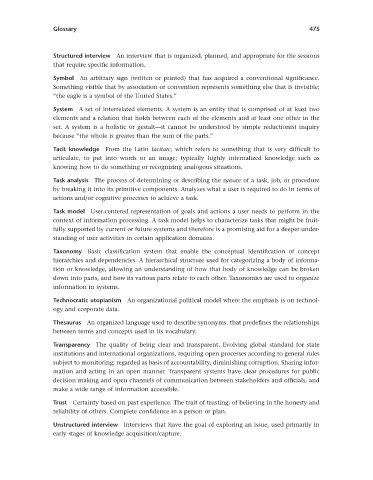Page 492 -
P. 492
Glossary 475
Structured interview An interview that is organized, planned, and appropriate for the sessions
that require specifi c information.
Symbol An arbitrary sign (written or printed) that has acquired a conventional signifi cance.
Something visible that by association or convention represents something else that is invisible;
“ the eagle is a symbol of the United States. ”
System A set of interrelated elements. A system is an entity that is comprised of at least two
elements and a relation that holds between each of the elements and at least one other in the
set. A system is a holistic or gestalt — it cannot be understood by simple reductionist inquiry
because “ the whole is greater than the sum of the parts. ”
Tacit knowledge From the Latin tacitare, which refers to something that is very diffi cult to
articulate, to put into words or an image; typically highly internalized knowledge such as
knowing how to do something or recognizing analogous situations.
Task analysis The process of determining or describing the nature of a task, job, or procedure
by breaking it into its primitive components. Analyzes what a user is required to do in terms of
actions and/or cognitive processes to achieve a task.
Task model User-centered representation of goals and actions a user needs to perform in the
context of information processing. A task model helps to characterize tasks that might be fruit-
fully supported by current or future systems and therefore is a promising aid for a deeper under-
standing of user activities in certain application domains.
Taxonomy Basic classifi cation system that enable the conceptual identifi cation of concept
hierarchies and dependencies. A hierarchical structure used for categorizing a body of informa-
tion or knowledge, allowing an understanding of how that body of knowledge can be broken
down into parts, and how its various parts relate to each other. Taxonomies are used to organize
information in systems.
Technocratic utopianism An organizational political model where the emphasis is on technol-
ogy and corporate data.
Thesaurus An organized language used to describe synonyms, that predefi nes the relationships
between terms and concepts used in its vocabulary.
Transparency The quality of being clear and transparent. Evolving global standard for state
institutions and international organizations, requiring open processes according to general rules
subject to monitoring; regarded as basis of accountability, diminishing corruption. Sharing infor-
mation and acting in an open manner. Transparent systems have clear procedures for public
decision making and open channels of communication between stakeholders and offi cials, and
make a wide range of information accessible.
Trust Certainty based on past experience. The trait of trusting; of believing in the honesty and
reliability of others. Complete confi dence in a person or plan.
Unstructured interview Interviews that have the goal of exploring an issue, used primarily in
early stages of knowledge acquisition/capture.

